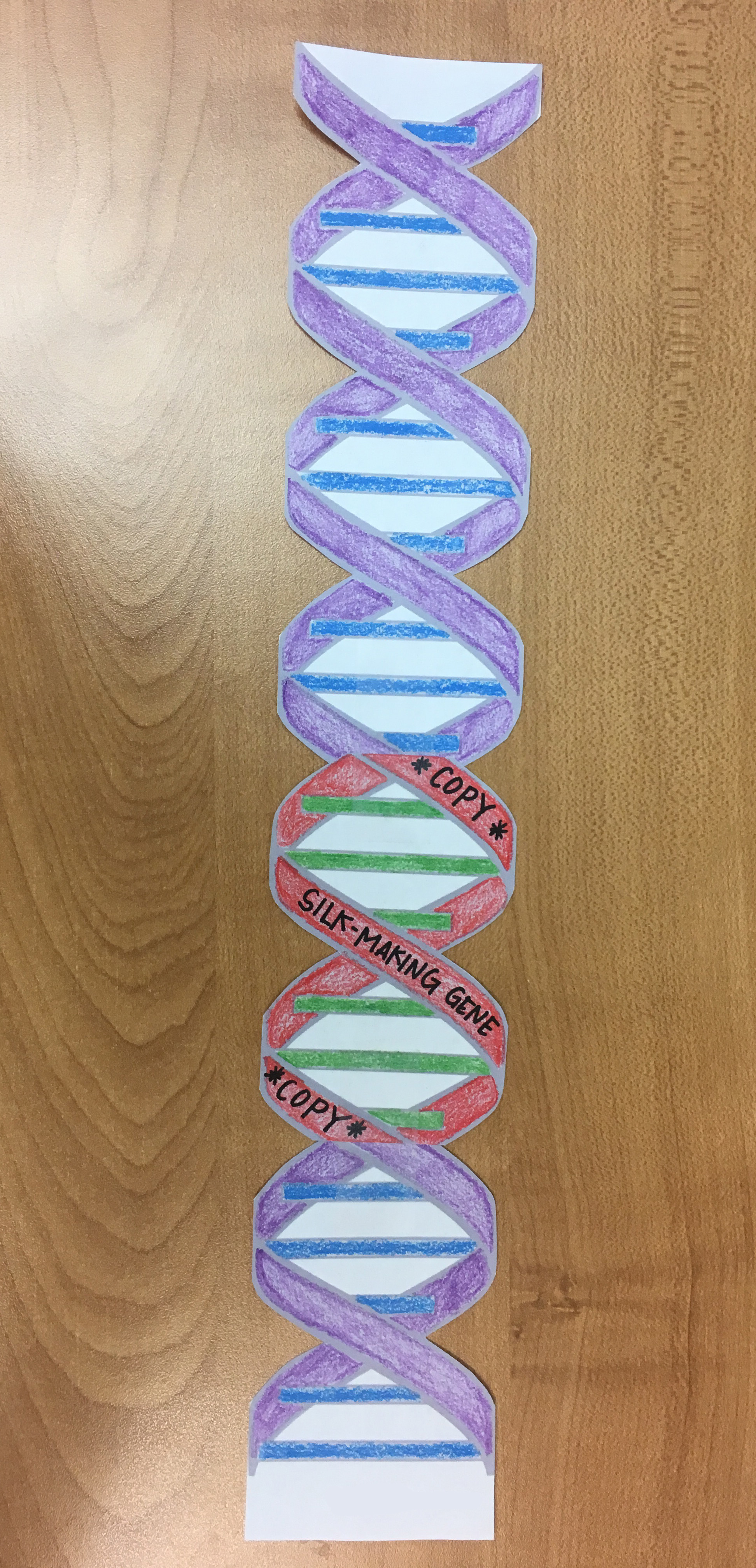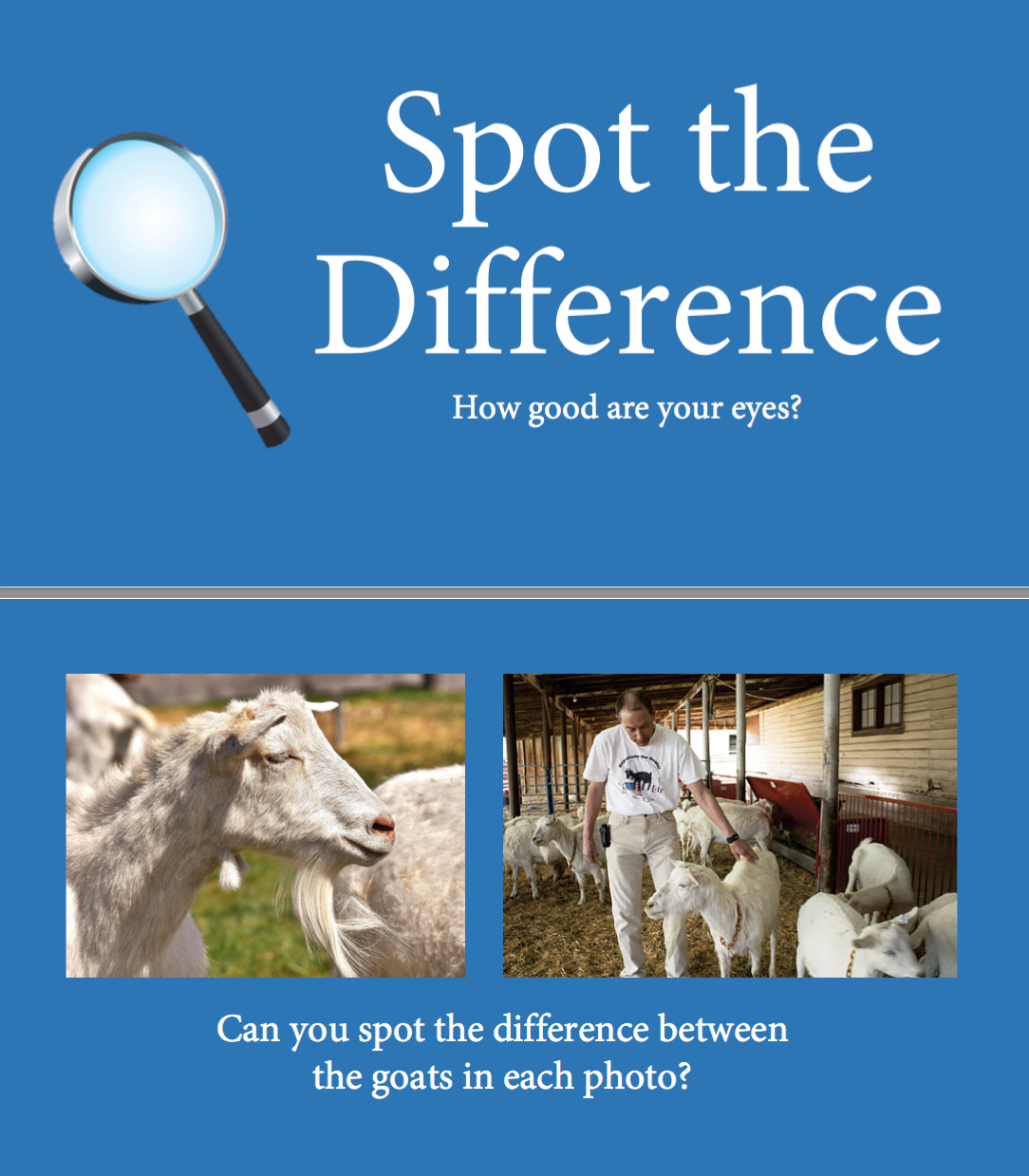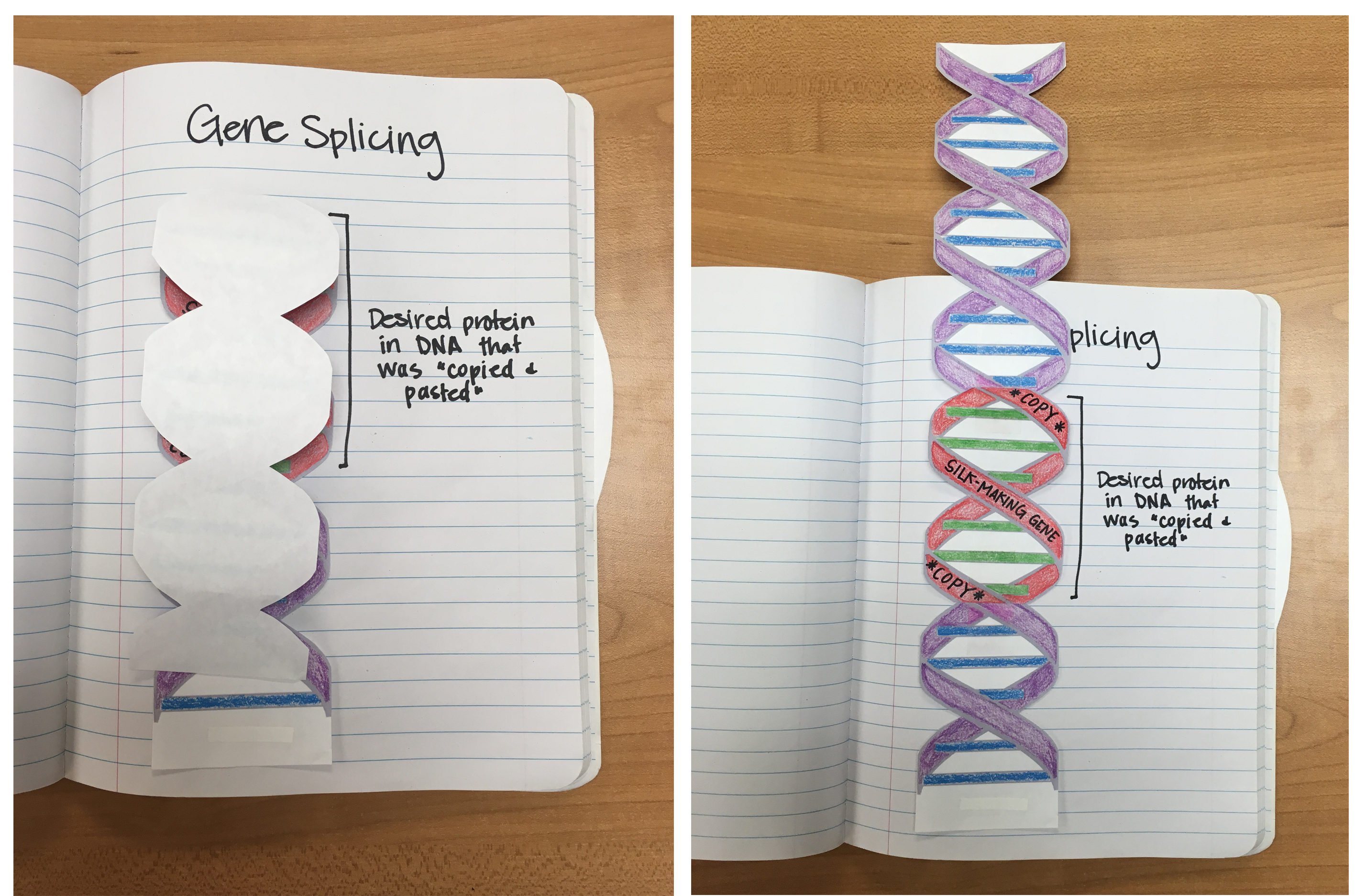Agricultural Literacy Curriculum Matrix
Lesson Plan
Silky Genes
Grade Level
Purpose
Students will simulate the process of gene splicing, understand the application of transgenic organisms in agriculture, and see how goats can be used for the production of goods other than meat and milk through the use of biotechnology. Grades 9-12
Estimated Time
Materials Needed
Activity 1: Splicing DNA
- Splicing DNA handout, 1 per student
Activity 2: Spider Goats
Vocabulary
deoxyribonucleic acid (DNA): deoxyribonucleic acid; a self-replicating material present in nearly all living organisms as the main constituent of chromosomes; the carrier of genetic information
double helix : the structure of a DNA molecule
dragline silk : the silk that spiders use to catch themselves when they fall
gene: a unit of heredity that is transferred from a parent to offspring and is held to determine some characteristic of the offspring
gene splicing : a technique used to join segments of DNA to form a new genetic combination
kevlar: a synthetic fiber that is used as a reinforcing agent in materials such as bullet-proof vests and parachutes because of its tensile strength
nitrogenous base: nitrogen-containing bases (adenine, guanine, thymine, cytosine) that attach to the backbone of DNA
recombinant DNA: joining together of DNA molecules from two different species that are inserted into a host organism to produce new genetic combinations
spider goat: a goat that contains spider genes and produces the protein for spider silk during lactation
transgenic: containing a gene that has been transferred from one organism to another and acts as a synonym for genetically modified
Did You Know?
- Goats are some of the earliest domesticated animals, between 6,000 and 7,000 B.C.1
- Goats will easily revert back to wild (feral) conditions given the chance – the only other animal to do this faster is the domestic cat.1
- The average dairy goat can produce 6-12 pounds of milk per day.2
- Currently, spider goats can’t be found on local farms or in backyards. They can be found at Utah State University, and previously at Wyoming State University, where researchers have been discovering more about spider silk production.
Background Agricultural Connections
Students should have a prior knowledge and understanding of the structure and function of DNA. It is helpful for students to understand the double-helix shape of DNA as well as the four nitrogenous bases.
When working on a computer, often times Ctrl+C and Ctrl+V are used to “copy and paste.” This same concept of copying and pasting happens during a process called gene splicing. Gene splicing is when a section from one DNA strand is copied and spliced (pasted) into another DNA strand. Gene splicing forms recombinant DNA. Gene splicing is used in plants and animals to create a transgenic organism.
When animals can produce a useful product for humans, they are often raised on farms for the production of these goods. For example, milk, meat, and eggs provide valuable nutrients to our diets. Cattle, pigs, sheep, goats, and poultry are all raised on farms for the production of these goods. Spider silk is a valuable resource. Dragline silk from spiders is 100 times stronger than natural ligaments, 10 times stronger than natural tendons, more elastic than nylon, and can be used to replace kevlar. Therefore, spider silk is considered an ideal material because of its versatile use. However, while it is useful, there are limitations in realistically producing it. First, spiders cannot produce large quantities of spider silk and second, they are nearly impossible to “farm” because of their cannibalistic nature. As an alternative, scientists have turned to biotechnology to find an alternative method of producing spider silk. How can this be accomplished? Within the genome of a spider is the DNA code for the protein responsible for producing silk. If a scientist could find a way to transfer the spider’s silk gene to another species, perhaps they could produce spider silk in another way.
Goats are common livestock animals found on farms. They produce meat, milk, and occasionally a fiber called mohair. While cow’s milk is most common in the United States for human consumption, goat milk has many merits. It is closer in structure to human milk and can sometimes be consumed by people who have allergic reactions to cow’s milk. Goats produce 6-12 pounds of milk per day. In comparison to dairy cows, goats are smaller and easier to manage. For these reasons, goats were chosen for this particular experiment. Scientists set out to try to splice the silk making gene from a spider into the genome of a goat.
Under the direction of Randy Lewis at Utah State University (originally at University of Wyoming), regular dairy goats are being used to produce spider silk. This is done by copying the silk-making gene in a spider’s DNA and splicing it into a goat’s DNA. This gene splicing gives goats the ability to produce the spider silk protein in their milk. These spider goats are then milked (just like any other milk goat) and the spider silk protein is extracted from the milk. The extraction takes place by freezing the milk and separating the fat. The thawed milk is then sifted, and the remaining fat molecules separate from the smaller silk proteins. In addition to goats, Utah State University has also started gene splicing with other transgenic organisms including alfalfa hay and silk worms.
Engage
- Play a round of What is it? Tell students that you are thinking of a thing. You will give them a series of clues, and you’d like them to raise their hand when they think they know what you are thinking of. Observe how many students raise their hand after each question. Allow students to guess as you go, or have them wait and guess at the very end.
- It is produced by an organism in very small quantities
- There are over 30,000 different species of this organism that produce it
- It is 10 times stronger than the tendons in your body
- It is more elastic than nylon
- It is being considered for use in parachutes, cables, and car airbags
- It can also be used to suture damaged eyes and even nerves
- It can be spun artificially or naturally
- The organism uses it for reproduction, foraging, protection, and as a dragline
- Use the paragraph below to introduce students to spider silk and its benefits and uses for humans.
- Dragline silk from spiders is 100 times stronger than natural ligaments, 10 times stronger than natural tendons, more elastic than nylon, and can be used to replace kevlar. Spider silk is considered an ideal material because of its versatile use. Even though spider silk is extremely versatile, it is very hard to acquire. Spiders cannot produce large quantities of silk at a time for human use, which makes it very difficult to raise spiders solely for silk production. In the New York Museum of Natural History, there is an 11-by-4-foot silk tapestry on display. In order to weave this tapestry, it took 80 people four years to harvest enough spider silk. Natural silk is spun from spiders like pulling floss from a floss dispenser while artificial silk is spun similar to squeezing toothpaste out of a tube.
- Finally, ask students how spider silk could relate to DNA. Allow students to share a few ideas before starting the next activities.
Explore and Explain
Activity 1: Splicing DNA
- Ask students what keyboard functions they use frequently on the computer. Some might give answers such as the delete key, the number keypad, copy and paste, etc. If no one answers “copy and paste” or "cut and paste" then guide students to that answer by asking leading questions such as, "How do you move information quickly on a computer without having to type the entire thing?" Inform students that the same “copying/cutting and pasting” concept can happen with DNA.
- Pass out the Splicing DNA handout to each student. Review the basic structure and function of DNA, including the four nitrogenous bases of DNA and sugar phosphate backbone. Students should also be able to discuss the purpose of DNA and how information is stored.
- Read through the instructions found on the Splicing DNA handout with your students.
- Be sure students understand that each DNA strand on the handout has been labeled and identified as DNA 1 and DNA 2. Complete the following steps as outlined in the handout.
- Color each DNA strand a different color (DNA 1 contains the desired trait and DNA 2 is the receiving strand).
- If you would like students to label the sugar phosphate backbone and nitrogenous bases, then this step can be added.
- Cut between the 2 solid lines on DNA 1 (this section produces the desirable protein).
- In this step, students will need to determine which section of the DNA 1 strand is the desirable trait (the segment between the solid lines). Relate to students that this is the section that needs to be "cut and then pasted."
- Cut out the DNA 2 strand to prepare for splicing.
- Carefully make ONE cut on the dotted line of DNA 2.
- Splice (insert) the cut-out section of DNA 1 into DNA 2 (where the dotted line was), and secure with tape. Your spliced DNA strand should now be longer than before and contain a different colored section.
- Color each DNA strand a different color (DNA 1 contains the desired trait and DNA 2 is the receiving strand).
- Review the scientific process of gene splicing, and ask students where this procedure could be useful.

Activity 2: Spider Goats
- Using the Spot the Difference PowerPoint, display the two different pictures of goats on the board (regular goat vs. a spider goat). Ask students the following questions:
- What is physically different about these goats? (Nothing is physically different. However, the goats on the right are called "spider goats." These goats look and behave like any other goat.)
- How are goats beneficial to society? (Students might answer that goats are used for pets or raised on farms for meat and milk. Inform students that this breed of goat is considered a dairy breed because it produces milk efficiently. However, the spider goat (on the right) produces something extra in its milk.)

- Leave the picture of the spider goat on the board and write “Transgenic” next to it. Define the word as an organism that contains genetic material that was artificially introduced from an unrelated organism. Discuss transgenic organisms and this particular spider goat on the wall. When asking the questions, let students brainstorm and discuss ideas as a class. Ask the following analytical questions:
- Why is this goat called a spider goat? (It contains a DNA gene from spiders which helps lactating female goats produce the spider silk protein in their milk.)
- Why would someone consider these transgenic spider goats to be good and beneficial? Provide reasoning. (Spider goats are not harmed during the process of producing silk. Their milk contains the spider silk protein which can be used to replace Kevlar for bullet-proof vests, parachutes, and medical sutures/binding.)
- Why would someone consider spider goats to be bad? Provide reasoning. (Some people might argue that this is unnatural for goats to produce spider silk.)
- Why do you think goats were used for this particular production? Why not cows or sheep? Provide reasoning. (Cows require more space and feed; goats are smaller and easier to manage. Dairy goats can produce 6-12 pounds of milk per day while sheep are mostly used for meat and wool.)
- Show the NOVA's 'Making Stuff' Explores Spinning of Steel-Strength Spider Silk video clip to students.
- Discuss the video clip, and refer back to the gene splicing activity. Consider using the following questions and ideas to guide a discussion:
- On your gene splicing activity, you copied the desirable gene from DNA 1 and pasted it into DNA 2. What was the desired gene in spiders that scientists “copied and pasted?" (The gene in a spiders’ DNA that produces spider silk.)
- By inserting the desired spider silk gene into a goat’s DNA, that goat now contains a specific protein. This gives goats the ability to do what? (Produce spider silk in their milk.)
- Why does the spider silk come out in the milk? (Scientists took the silk-producing gene from spiders and pasted it among the DNA gene of goats that prompts milk production.)
- Students should now be able to relate DNA 1 to “Spider DNA” and DNA 2 to “Goat DNA." The section they copied is the silk-producing gene. Where they inserted this gene into the goat, codes for milk production.
| It's important to be sure your students understand that spider goats do not produce the actual silk in their milk. The milk looks just like any other milk. However, it contains an additional protein that can be extracted from the milk and used to make synthetic spider silk with the same beneficial properties. |
*If you use interactive notebooks, this gene splicing activity can be inserted into students’ notebooks and then folded to open and close. 
Elaborate
-
Prompt students to think critically by having them create their own transgenic goats:
- Review the definition of the word, transgenic.
- Discuss the possibility of using goats for other transgenic purposes. Ask, “Are there other organisms with useful genetic traits that we can take the DNA from and use in goat DNA?”
- Instruct students to research another organism (plant or animal) that produces something useful and why they would want to splice that organism’s DNA into a goat’s DNA. There is no “right" or "wrong” answer as long as students are thinking critically about gene splicing and producing something new in goat’s milk.
- Note: It is important that students understand this is NOT simply crossbreeding animals (i.e., breeding a sheep and a goat together).
- Give each student access to the internet for research and ideas. Presentations can be done in a variety of ways (poster boards, PowerPoint, Prezi, etc.)
- Encourage students to find genetic traits from plants or animals to splice with their goat DNA. The more creative they are, the better! For example, taking the aloe producing gene from an aloe vera plant and splicing it with a goat’s DNA so the milk naturally contains aloe vera for goat milk soaps and lotions.
-
Read about the research taking place for the utilization of spider silk in medicine and as fabric for army uniforms.
Evaluate
After conducting these activities, review the following key concepts:
- Farm animals produce valuable goods such as food and fiber.
- Biotechnology is the use of technology to manipulate biological processes for the production of useful goods.
- Synthetic spider silk can be produced from a protein found in the milk of a transgenic 'spider goat.'
- Gene splicing is the process of cutting a specific portion of an organism's DNA (gene) for the purpose of inserting it in another organism.
Sources
- http://www.ansi.okstate.edu/breeds/goats/
- https://www.thejudgingconnection.com/pdfs/670_Comparing_Dairy_Goats_To_Cows.pdf
- Spider goat image found on Spot the Difference PowerPoint courtesy of USU.
- https://www.deseretnews.com/article/705375752/A-web-of-possibilities-Utah-researcher-uses-goats-to-make-one-of-the-strongest-known-substances.html
- https://www.youtube.com/watch?v=xossR6eHv3I&t=99s
- https://www.youtube.com/watch?v=2nya8sPWKOA (toothpaste reference)
- http://knowgenetics.org/recombinant-dna-technology/
- https://www.theguardian.com/science/2012/jan/14/synthetic-biology-spider-goat-genetics
- http://archive.industry.gov.au/Biotechnologyonline.gov.au/topitems/glossary.html#gene
Recommended Companion Resources
Author
Organization
| We welcome your feedback! If you have a question about this lesson or would like to report a broken link, please send us an email. If you have used this lesson and are willing to share your experience, we will provide you with a coupon code for 10% off your next purchase at AgClassroomStore. |
